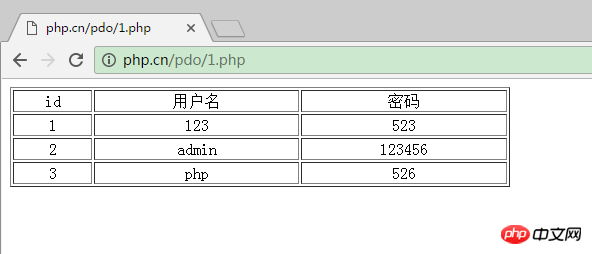Home > Article > Backend Development > Detailed explanation of the fetchAll() method for obtaining result sets in PDO
Detailed explanation of the fetchAll() method for obtaining the result set in PDO
The fetchAll() method obtains all rows in the result set and returns a Binary array of rows!
So in the previous article "Detailed Explanation of the fetch() Method for Obtaining Result Sets in PDO", we introduced the fetch() method to obtain the result set. We will introduce the fetchAll( ) method is similar to the previous method fetch(), but this method only needs to be called once to get all the rows in the result set and assign them to the returned array (two-dimensional).
The syntax format of the fetchAll() method is as follows:array PDOStatement::fetchAll ([ int $fetch_style [, mixed $fetch_argument [, array $ctor_args = array() ]]] )Parameter fetch_style: Controls the return method of data in the result set. The optional values are as follows:
| Said Ming | |
| Associative array form | |
| Numeric index array form | |
| Both array forms are available, this is the default | |
| According to the form of the object, similar to the previous mysql_fetch_object() | |
| Return the result in the form of a Boolean value, and assign the obtained column value to the variable specified in the bindParam() method | |
| to Results are returned in three forms: associative array, numeric index array, and object. |
<?php
header("Content-Type:text/html; charset=utf-8"); //设置页面的编码格式
$dbms = "mysql"; // 数据库的类型
$dbName ="php_cn"; //使用的数据库名称
$user = "root"; //使用的数据库用户名
$pwd = "root"; //使用的数据库密码
$host = "localhost"; //使用的主机名称
$dsn = "$dbms:host=$host;dbname=$dbName";
try{
$pdo=new PDO($dsn,$user,$pwd);//初始化一个PDO对象,就是创建了数据库连接对象$pdo
$query="select * from user";//需要执行的sql语句
$res=$pdo->prepare($query);//准备查询语句
$res->execute(); //执行查询语句,并返回结果集
?>
<table border="1" width="500">
<tr>
<td height="22" align="center" valign="middle">id</td>
<td height="22" align="center" valign="middle">用户名</td>
<td height="22" align="center" valign="middle">密码</td>
</tr>
<?php
$result=$res->fetchAll(PDO::FETCH_ASSOC) ; // 获取结果集中的所有数据。
for ($i=0;$i<count($result);$i++){ //循环读取二维数组中的数据。
?>
<tr>
<td height="22" align="center" valign="middle"><?php echo $result[$i]['id'];?></td>
<td height="22" align="center" valign="middle"><?php echo $result[$i]['username'];?></td>
<td height="22" align="center" valign="middle"><?php echo $result[$i]['password'];?></td>
</tr>
<?php
}
}catch(Exception $e){
die("Error!:".$e->getMessage().'<br>');
}
?>
</table>The output results are as follows:

Detailed Explanation of the fetchColumn() Method for Obtaining Result Sets in PDO"!
The above is the detailed content of Detailed explanation of the fetchAll() method for obtaining result sets in PDO. For more information, please follow other related articles on the PHP Chinese website!